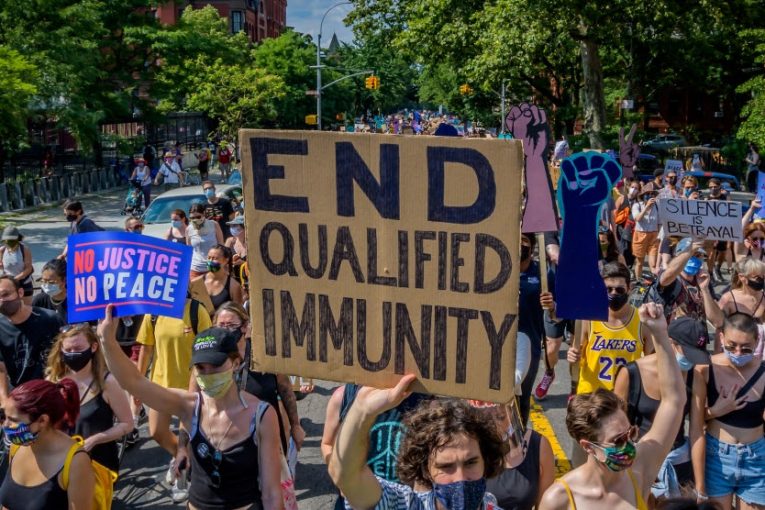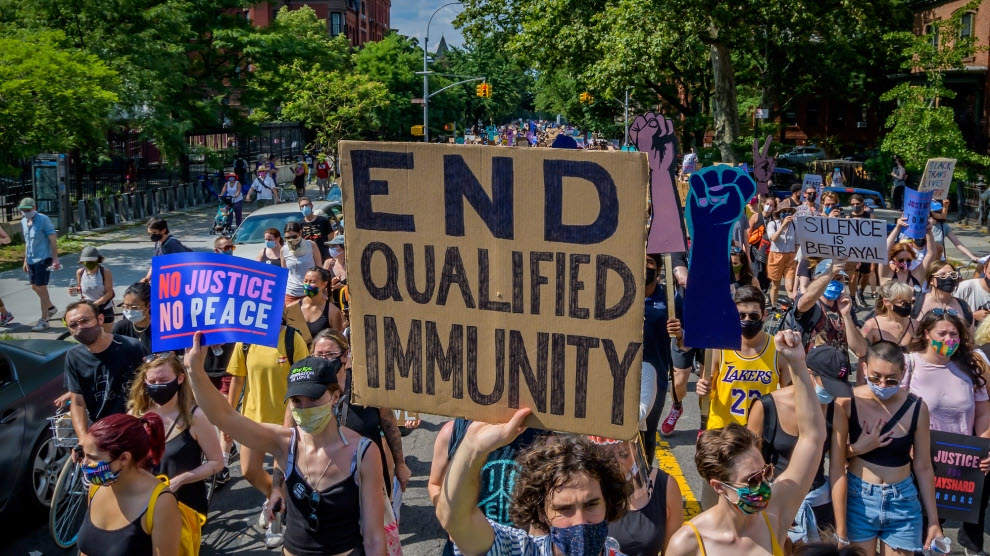

By David M. Greenwald
Executive Editor
Washington, DC – While cases involving abortion, conceal-carry and prayer at football games drew the headlines, the Supreme Court drew far deeper than that.
In 2020, amid the backlash against the killing of George Floyd, there seemed a time when the court and policymakers could take on qualified immunity. But just as the court moved backwards in other areas, qualified immunity only grew stronger this term, as the majority on the court consistently voted to shield police officers, border agents, prison guards and other government officials from liability for their misconduct.
As Matt Ford of The New Republic argues this week in an op-ed, “The justices consistently ruled against plaintiffs who had their constitutional rights violated—and, in some cases, their bodies abused—by police, the Border Patrol, and the CIA.”
Ford points out that there was no single ruling where the Supreme Court has declared something like, “Government officials should not be held accountable for their actions.” However, he argued, “the justices have come fairly close in the aggregate weight of their rulings, both this term and in previous ones. The result is the steady erosion of Americans’ ability to vindicate themselves in court—and sweeping impunity for those who violate them.”
The remedy when a police officer violates someone’s constitutional rights in their official capacity is for a person to file a lawsuit under Section 1983, Title 42 of the U.S. Code.
That’s what happened in Vega v. Tekoh. Terence Tekoh filed under Section 1983 to sue a Los Angeles police officer who had interrogated him without giving him a Miranda warning.
Prosecutors attempt to use his un-Mirandized statements against him but the jury found Tekoh not guilty of sexual assault.
Tekoh sued the officer and others for not Mirandizing him before the questioning, which Tekoh’s lawyers described as coercive.
While the Ninth Circuit Court of Appeals allowed the suit to go forward, the Supreme Court overruled them.
In a 6-3 decision, the court found that the Miranda rule did not fall under Section 1983.
Justice Samuel Alito explained that “while the benefits of permitting the assertion of Miranda claims under Section 1983 would be slight, the costs would be substantial” for the courts. Alito saw Miranda itself as a procedural rule—however, Justice Elena Kagan, in dissent, argues that Alito and the majority had misunderstood Miranda which should be considered not as a procedural rule but rather as a constitutional rule. Not one that merely excluded evidence, but one that created accompanying rights.
As Ford points out, Kagan noted the practical consequences for future litigants, who, unlike Tekoh, have been found guilty and are serving time in prison.
That plaintiff “may succeed, on appeal or in habeas, in getting the conviction reversed,” she wrote, quoting from past rulings. “But then, what remedy does he have for all the harm he has suffered? The point of Section 1983 is to provide such redress—because a remedy ‘is a vital component of any scheme for vindicating cherished constitutional guarantees.’ The majority here, as elsewhere, injures the right by denying the remedy.”
Then there is the ruling in Egbert v. Boule.
Robert Boule owns an inn on the US-Canadian border, appropriately named Smuggler’s Inn, and has “a long history of helping people illegally enter Canada for money, as well as a track record of working as an informant for federal law enforcement agencies that patrolled the border.”
Ford notes that Boule sued following an incident in which “a Border Patrol agent had aggressively entered proprietor Robert Boule’s property without a warrant to question one of the inn’s guests, threw Boule to the ground and injured him, and then allegedly retaliated against him for filing an administrative grievance with the agent’s supervisor.”
Boule alleged the agent violated his Fourth Amendment rights during the initial episode and his First Amendment rights in the retaliation.
In 1971, the Supreme Court in Bivens allowed Webster Bivens to sue “six federal narcotics agents who violated his Fourth Amendment rights, even though Congress had not created a cause of action that would allow him to do it. The cause of action, the justices reasoned, was implicit from the constitutional text.”
However, conservatives have been limiting the scope of Bivens and in this case, Justice Thomas ruled that Biven could not go forward “if the federal government had provided an ‘alternative mechanism’ for citizens to seek redress for an injury to their constitutional rights.”
“So long as Congress or the Executive has created a remedial process that it finds sufficient to secure an adequate level of deterrence, the courts cannot second-guess that calibration by superimposing a Bivens remedy,” he wrote.
Ford notes, “Thomas emphasized that this was acceptable even if the executive branch’s alternative process didn’t allow someone in Boule’s position to participate or appeal the outcome.”
Justice Sonia Sotomayor, writing in dissent, argued that the majority was inventing new standards.
“Existing precedent permits Boule to seek compensation for his injuries in federal court,” she wrote. “The Court goes to extraordinary lengths to avoid this result: It rewrites a legal standard it established just five years ago, stretches national-security concerns beyond recognition, and discerns an alternative remedial structure where none exists. The Court’s innovations, taken together, enable it to close the door to Boule’s claim and, presumably, to others that fall squarely within Bivens’ ambit.”
There was also United States v. Zubaydah, dealing with the CIA’s use of torture against detainees, which did not fall along normal ideological lines.
Abu Zubaydah, is still being held at the Guantánamo Bay facility today. He and his lawyers sought to subpoena two former CIA contractors who had participated in his torture on behalf of prosecutors in Poland, where the torture allegedly took place at a CIA “black site.”
The Court here ordered the lower courts to dismiss the case.
“We agree with the Government that sometimes information that has entered the public domain may nonetheless fall within the scope of the state secrets privilege,” Justice Stephen Breyer wrote for the court. “The government here has provided a reasonable explanation of why Mitchell and Jessen’s confirmation or denial of the information Zubaydah seeks could significantly harm national security interests, even if that information has already been made public through unofficial sources.”
Ford notes, “The ruling will make it harder for people to hold the government accountable for constitutional violations that it commits in the national security context, even in cases where the facts are already widely known.”
Justice Gorsuch wrote the dissent joined this time by Justice Sotomayor.
“The events in question took place two decades ago,” he wrote. “They have long been declassified. Official reports have been published, books written, and movies made about them. Still, the government seeks to have this suit dismissed on the ground it implicates a state secret—and today the Court acquiesces in that request. Ending this suit may shield the government from some further modest measure of embarrassment. But respectfully, we should not pretend it will safeguard any secret.”
The court did address qualified immunity, though Ford notes “the court rarely takes qualified immunity cases head-on. It often instead resolves them through summary reversals of the lower courts, without oral arguments or signed opinions by the majority. In some circumstances, it also simply lets inexplicable decisions by the lower courts stand without further review, over the dissents of some of the justices.”
For example, in Ramirez v. Guadarrama, the court announced on the last day of the term this year that it would not take up the case.
The case stemmed from a 2017 911 call by the family that the husband, Gabriel Eduardo Oliva, “was experiencing a mental health crisis during which he doused himself in gasoline and threatened to light himself on fire inside their home.”
Police arrived on the scene, and despite warning from the family not to use their Taser because it would ignite the gasoline, the police ignored the warning, and hit him with the Taser which ignited the gasoline. As a result, Olivas died and the family’s home was burned down.
The family sued the officers for violating the Fourth Amendment by using excessive force against Olivas.
Ford notes, “When the officers claimed qualified immunity, the district court declined to apply it at first.”
But the Fifth Circuit overruled the lower court and said the officers were entitled to immunity, finding that “given the horrendous scene that the officers were facing, involving the immediate potential for the destruction of lives and property, the force used—firing tasers—was not unreasonable or excessive.”
The Court’s three liberal justices criticized the court’s failure to review the case. “According to those allegations, the officers elected to use force knowing that it would directly cause the very outcome they claim to have sought to avoid,” Sotomayor wrote. “That is, to prevent Olivas from lighting himself on fire and burning down the house, the officers tased Olivas just after they were warned that it would light him on fire.”
Writes Ford, “This absurdity apparently did not persuade the other justices to intervene.”






